This is the fifth in a series of blogs tied to SACE’s third annual “Energy Efficiency in the Southeast” report. Each year SACE compiles efficiency performance data from nearly 500 electric utilities in the Southeast. The first four blogs in this series introduced this year’s efficiency report; highlighted Duke Energy’s performance as a regional leader; identified ways Duke can still strive for higher savings on par with national leaders, and highlighted new pressures on Dominion Energy to pursue more energy efficiency through its integrated resource plan. Our attention now turns to how the Tennessee Valley Authority’s (TVA) decision to eliminate nearly all of its efficiency programs is impacting the region, and a possible new vision for TVA as a clean energy leader. In the coming weeks, additional blogs will highlight individual states, utilities, and key trends affecting energy efficiency in the region.
[button color=”blue” url=”https://bit.ly/seeereport21″]Download the Report[/button]
[button color=”blue” url=”https://cleanenergy.org/?s=SEEnergyEfficiencyReport2021″]Read the Report Series[/button]
[button color=”blue” url=”https://cleanenergy.org/news-and-resources/energy-efficiency-in-the-southeast-third-annual-report-webinar/”]Watch the report webinar[/button]
The Tennessee Valley Authority was once a symbol of American progress and a powerful force for improving the lives of regular citizens. Founded as part of the New Deal in the 1930s, its mission sought to bring modern electric power and job creation to a region that was being economically left behind.
But over the years, TVA lost its way. Like when it axed its solar program, stalls decarbonization, impedes local power companies from pursuing clean energy, and just wastes customer dollars on extravagant executive compensation and luxury jets.
Another example is energy efficiency. As shown below, efficiency is the proven least-cost energy resource that both helps customers cut their monthly energy bills and reduces the carbon pollution that is driving our climate crisis. Instead, TVA wants to build more expensive fossil gas power plants, which will only drive customer costs up.
Energy Efficiency is the Least Cost Energy Resource
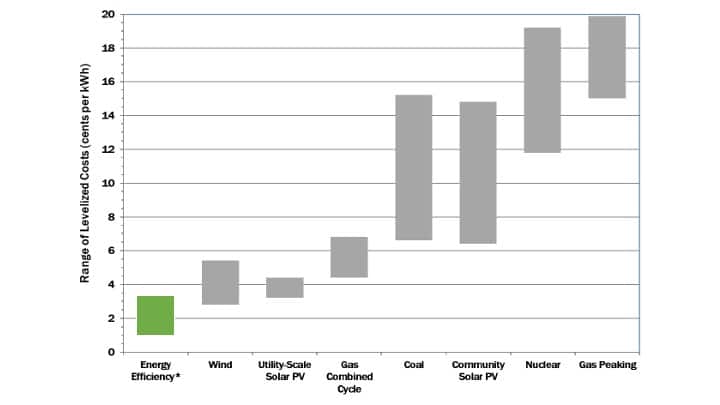
Comparing Giants
Today, TVA is a behemoth. Its service territory covers most of Tennessee, portions of Alabama, Mississippi, and Kentucky, and even extends into Georgia, North Carolina, and Virginia. It is the nation’s largest public power company and has annual electricity sales that rival the Southeast’s largest investor-owned utility company, Duke Energy. In 2019, TVA accounted for 19% of all electricity sold in the Southeast, roughly equal to the 20% attributed to Duke’s operations in North Carolina, South Carolina, and Florida. But when it comes to energy efficiency, the total energy savings from these utilities are very unequal.
In 2013, Duke and TVA actually had similar levels of annual efficiency savings. But since then TVA’s saving declined steeply to just 32 GWh in 2019, while Duke’s rose to 1,260 GWh – roughly 40 times higher than TVA. Duke’s efficiency savings as a percentage of annual electric sales is now 0.76%, while TVA is at a mere 0.02%.
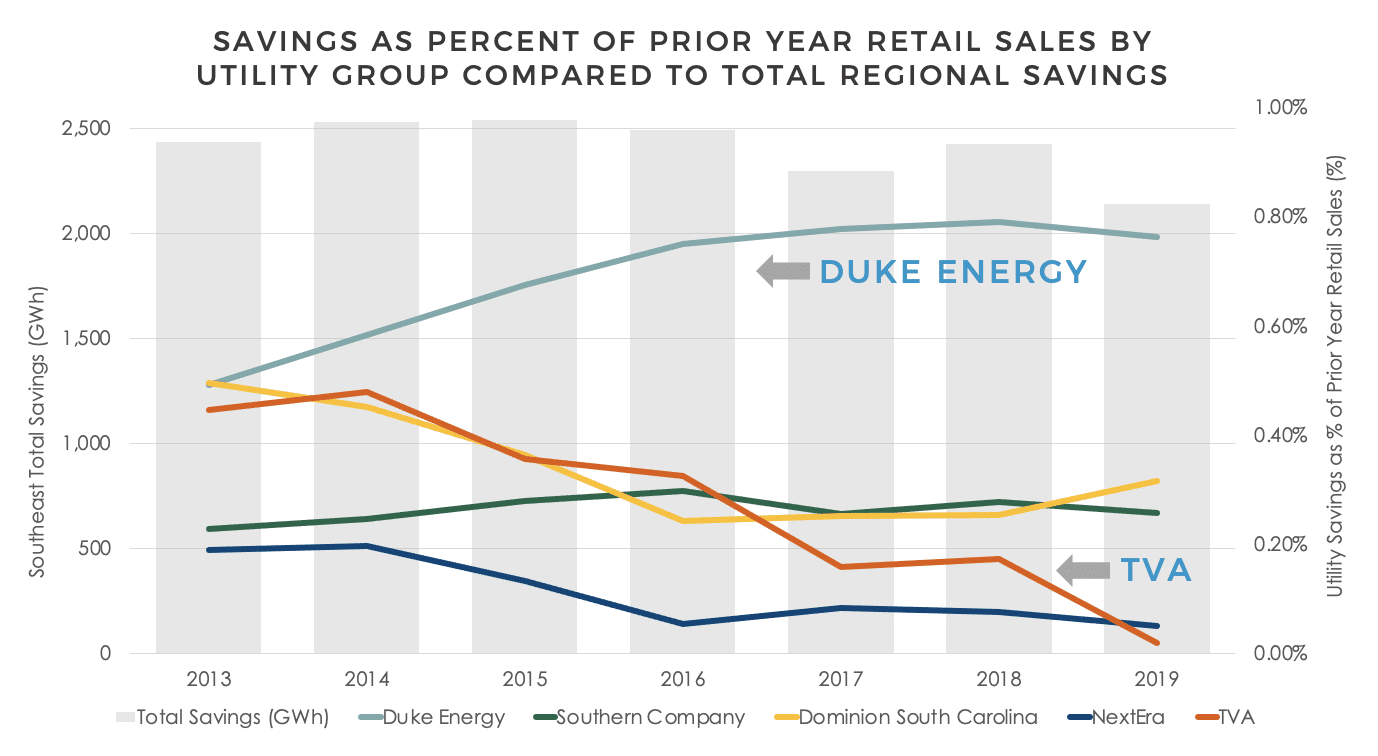
Funding Slashed, A Retreat from Incentives
From 2014-18, TVA cut its already limited efficiency spending by nearly two-thirds while completely eliminating its customer incentive programs. In 2019, the cuts went even further. That leaves educational workshops and minimal investment in low-income efficiency programs, which now require matching funds from local utilities that many cannot afford.
TVA still publishes a self-congratulatory annual report that glosses over its near-total elimination of energy efficiency, but the impact is obvious when compared to other utilities. As noted above, because of TVA’s size, the regional average itself is substantially lower as a direct result of poor efficiency performance at TVA and NextEra. Even the national average understates just how far TVA has fallen behind major utility peers. In an analysis of the nation’s 52 largest electric utilities, the American Council for an Energy Efficient Economy (ACEEE) determined that the average annual efficiency savings for major utilities in 2018 were 1.03%, 50 times higher than TVA.
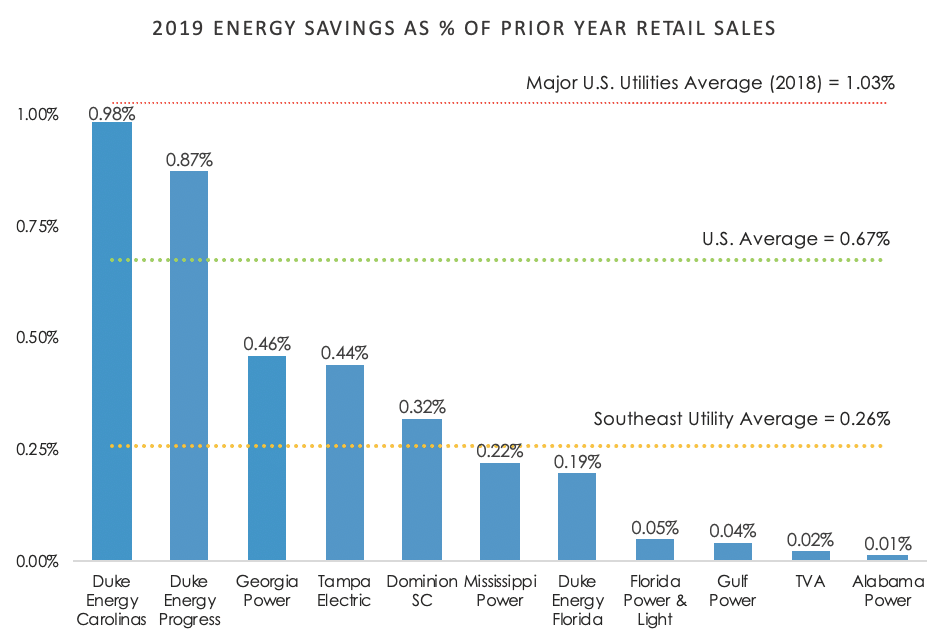
Dragging Efficiency Performance Down for the Southeast Region
Two mega-utilities have an outsized negative effect on efficiency in the Southeast. Just a few years ago, TVA and NextEra (including Florida Power & Light and Gulf Power) were important contributors to the region’s total Southeast savings. As noted above, Duke is delivering efficiency savings well in excess of its footprint in the Southeast, while Southern Company and Dominion South Carolina have efficiency savings that are roughly proportionate to their percentages of regional electric sales. But compared to their peers, TVA and NextEra stand out for their absolutely abysmal efficiency performance. In 2019 Duke delivered 59% of the region’s total efficiency savings, while TVA accounted for just 1%.

Because TVA and NextEra are such large utilities, big changes in their efficiency programs have an outsized effect on efficiency performance for the whole region. In 2019, TVA alone was responsible for dragging the regional average down by almost one-fifth. If both TVA and NextEra are removed, the regional average for 2019 jumps from 0.26% up to 0.37%.
Despite its already low performance in previous years, TVA’s decision to scrap nearly all of its residential incentive programs tanked savings for the state of Alabama, leading to a single year from 48 GWh in 2018 to 11 GWh in 2019, while Tennessee went from 174 GWh to just 25 GWh. That is a single-year decline of 86%.
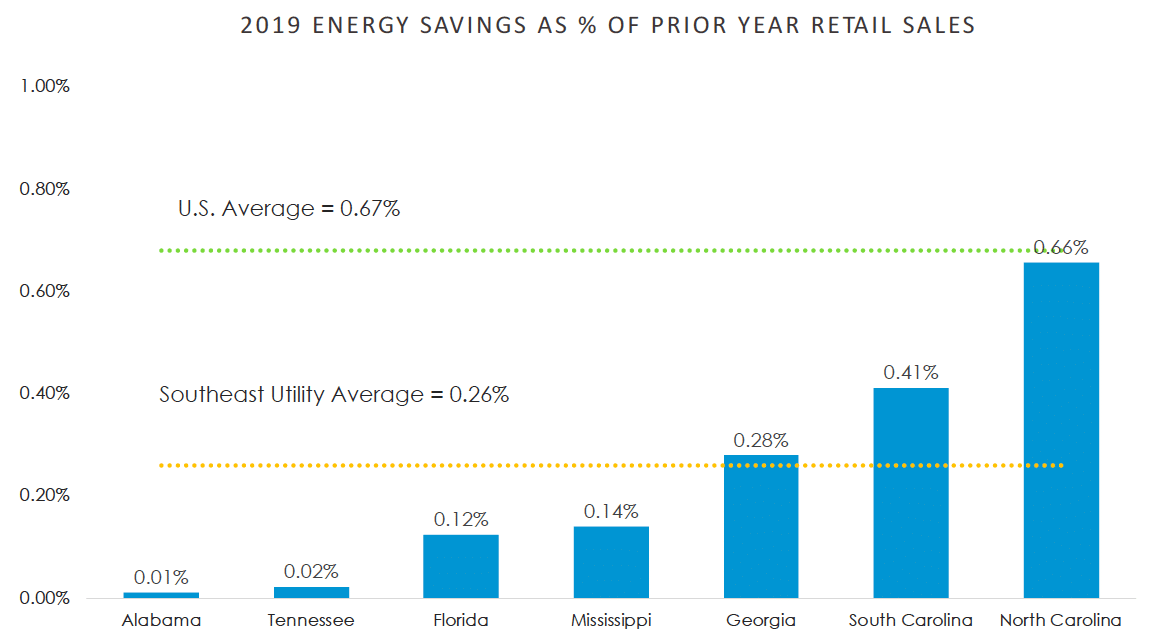
It Wasn’t Always This Way
At one time, TVA was actually considered an innovator for allowing energy efficiency to compete against traditional power generation in its integrated resource planning (IRP). TVA’s 2011 IRP showed that rapid increases in energy efficiency investment would lower customer bills, but actual performance ultimately fell short of plans. Nevertheless, when energy efficiency and supply resources were evaluated again in TVA’s 2015 IRP, the models once again showed that the least-cost mix of energy resources required a large investment in energy efficiency. But what TVA was actually doing was just the opposite.
By 2019 the utility dropped its pretense and blatantly undermined efficiency in the IRP with unrealistic costs and spending caps imposed before it conducted any modeling against supply resources. In effect, TVA now has no efficiency resource strategy.
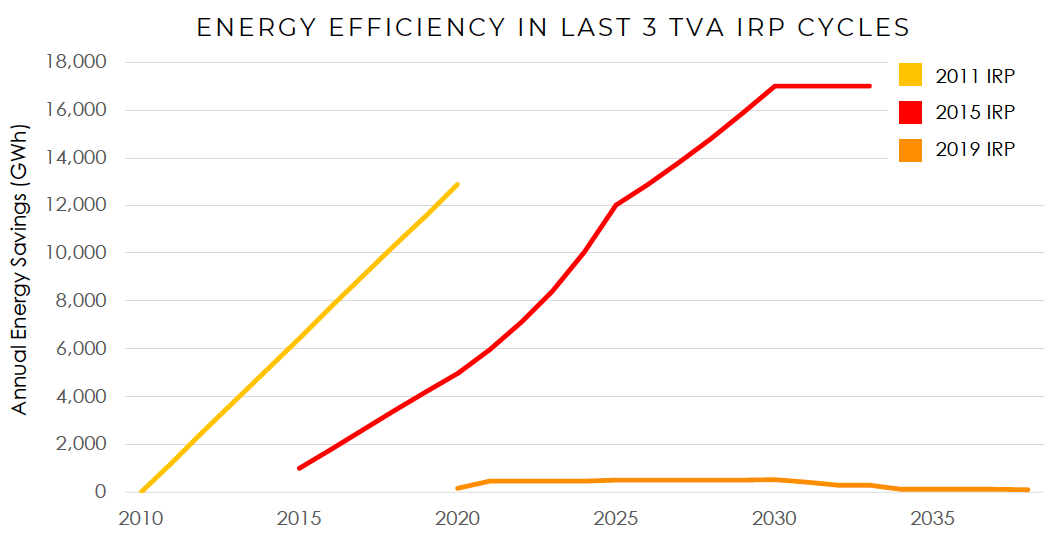
Could there be a Brighter Future for TVA?
The new Biden Administration is prioritizing energy efficiency as a tool to reduce carbon emissions and build a stronger economy. While the Southeast has historically lagged behind other regions on efficiency, examples of clean energy leadership are emerging in the region. The fact is, our nation’s energy transition must include the South.
As a federally managed utility, the Biden Administration could once again present a grand vision for TVA that hails back to its New Deal roots with a major focus on decarbonization and job-creation. TVA’s successful new clean energy practices could then be exported across the country, thereby helping the nation to innovate to meet the administration’s climate goals. Meanwhile, major investments in energy efficiency and renewable energy would put people in the region back to work, as we turn the corner after the economic pains associated with the COVID- 19 pandemic.
Find out more from our Third Annual “Energy Efficiency in the Southeast” Report and blog series below:
[button color=”blue” url=”https://bit.ly/seeereport21″]Download the Report[/button]
[button color=”blue” url=”https://cleanenergy.org/?s=SEEnergyEfficiencyReport2021″]Read the Report Series[/button]
[button color=”blue” url=”https://cleanenergy.org/news-and-resources/energy-efficiency-in-the-southeast-third-annual-report-webinar/”]Watch the report webinar[/button]
#SEEnergyEfficiencyReport2021



